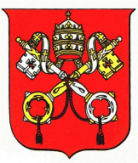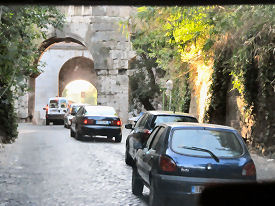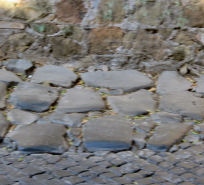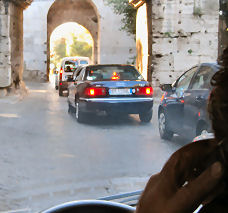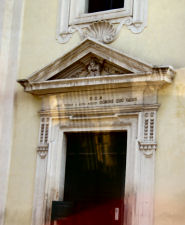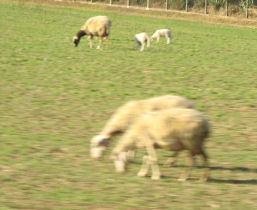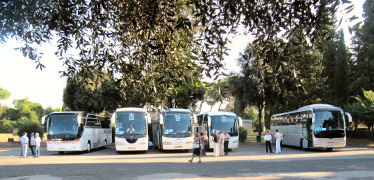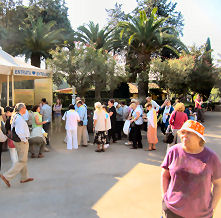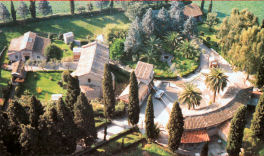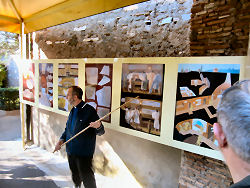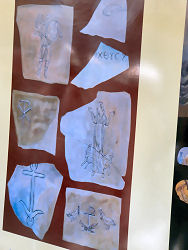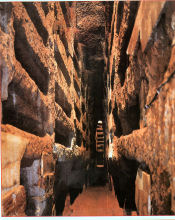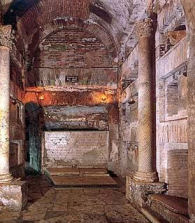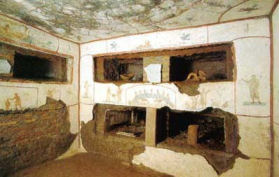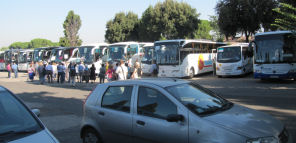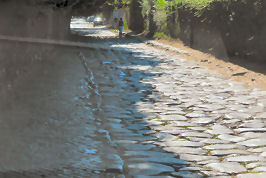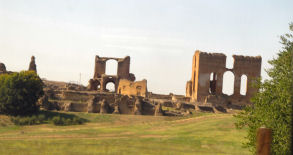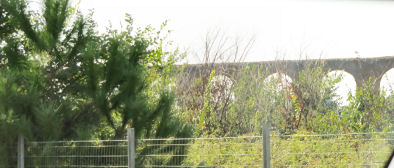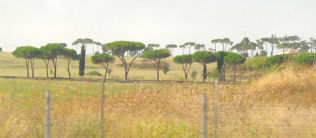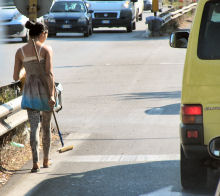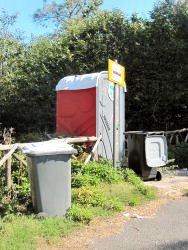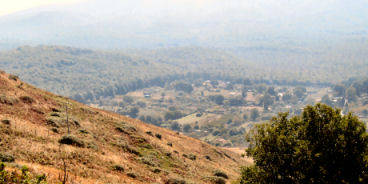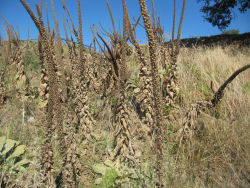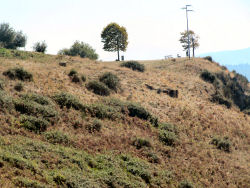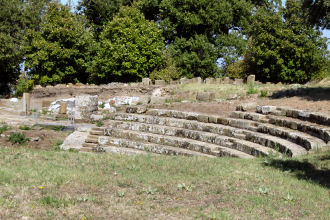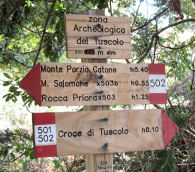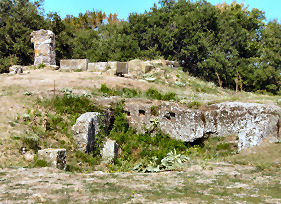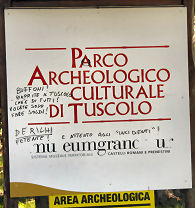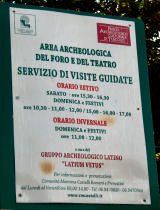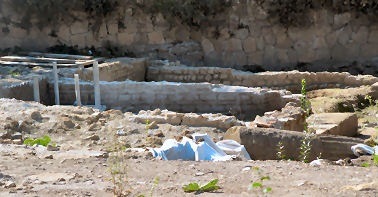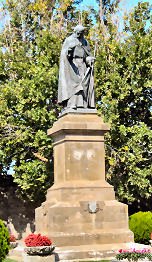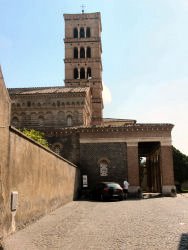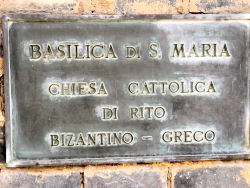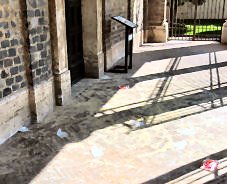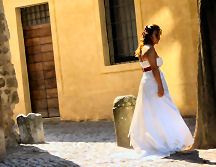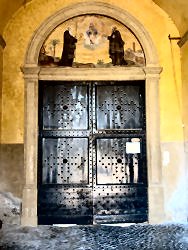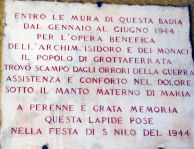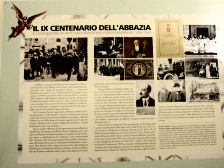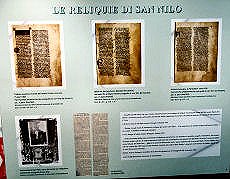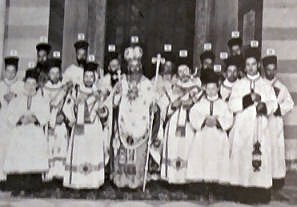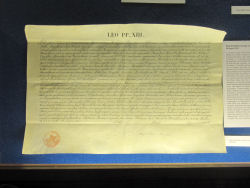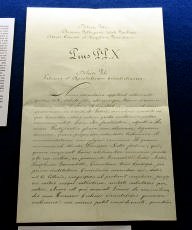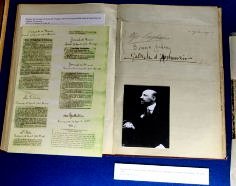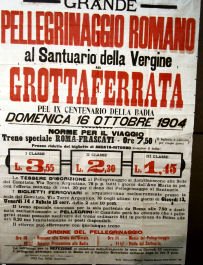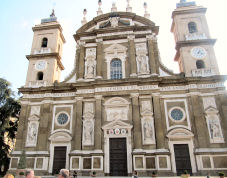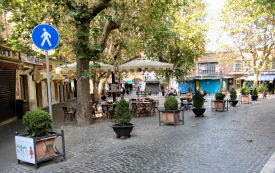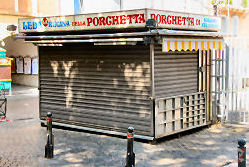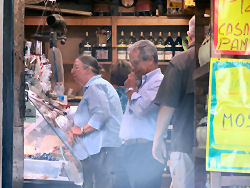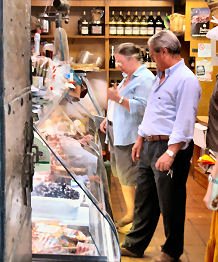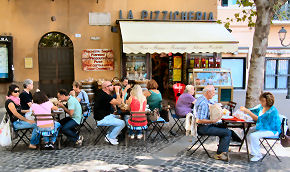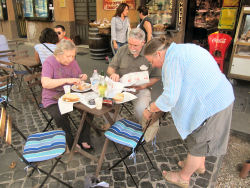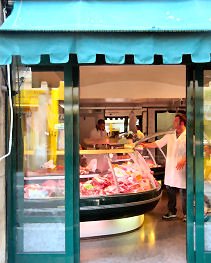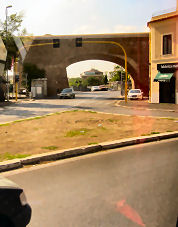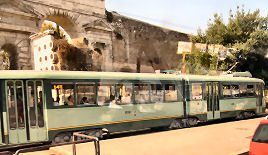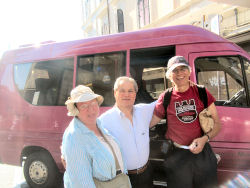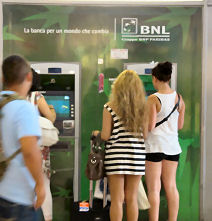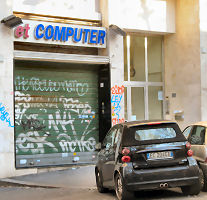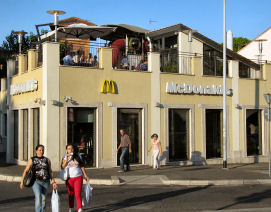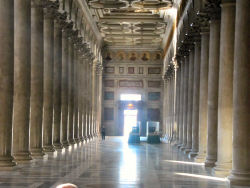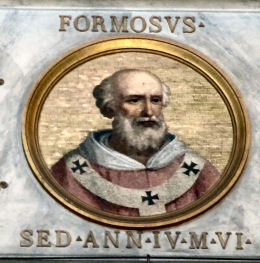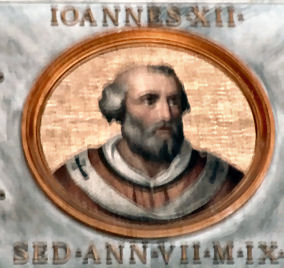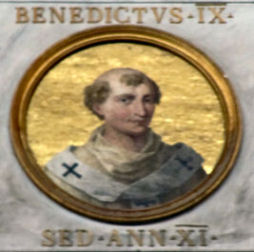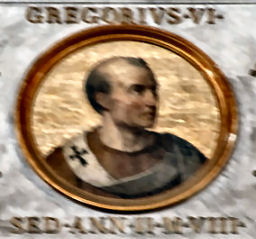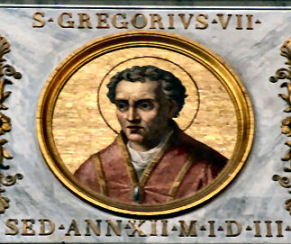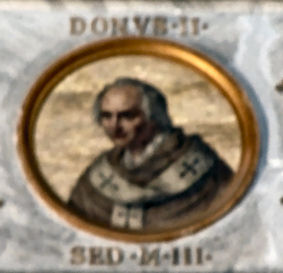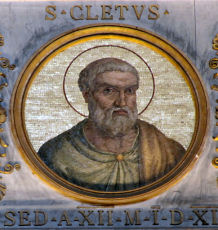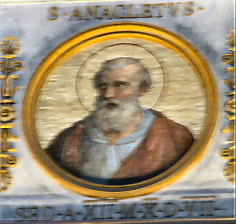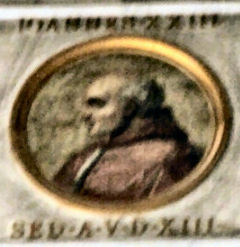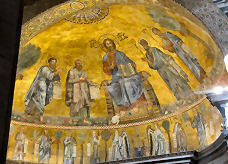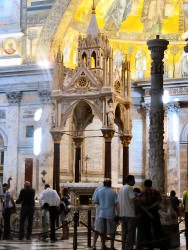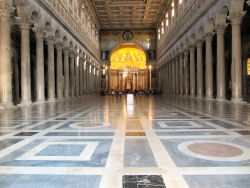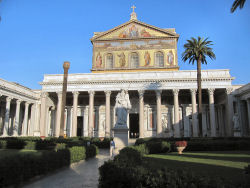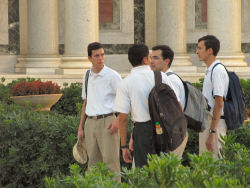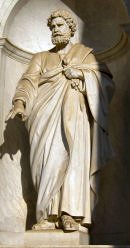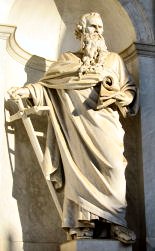Sue and I were both awake at 1:30, and neither of us could get back to sleep until after three. I cannot imagine why. I was physically exhausted when I hit the hay, and that generally assured me a good night’s sleep unless I develop leg cramps. Even then I generally could get right back to sleep after performing the cramp dance.
The plan for today was to take a car down the ancient Appian Way on the southern edge of the city to the Catacombs of Saint Callixtus. We then planned to spend the rest of the day in the Alban Hills, an area south of Rome. It is often referred to as the Castelli Romani. In the eleventh century a family who lived there had totally dominated Rome and the papacy. I wanted to see what was left of the town in which they had lived and to imagine what their lives might have been like in those days. We also planned to spend a little time in Frascati, which reportedly had the best white wine in the area and was also famous for its fresh roast pork. I had arranged via e-mail for a driver named Concezio (“Ezio”) Monti to pick us up at the hotel at 9:00. He was recommended in Rick Steves' travel book for Italy.We woke up again at 7:20 and went to breakfast with the Corcorans. All four of us seemed to be in a mental fog. I noticed that Tom and Patti were standing next to a table with dirty dishes on it. I moved the dishes to another nearby table that also contained dirty dishes so that we could claim the clean one.
Sue reported that a list of airport transportation assignments had been posted for the Rick Steves group that was also staying in our hotel. Many of them were in the breakfast room sharing memories about their experiences.It promised to be another beautiful day. The temperature was forecast to top out in the eighties, and there was nary a cloud in the sky.
We gathered outside the hotel at a little after nine to meet Ezio. He finally showed up at about 9:15 in a pink van. He explained that he had been waiting for us at the nearby Hotel Sonja for the last half hour. I was quite certain that I had given him the name and address of our hotel. I certainly never said that we were at the Hotel Sonja. It sure was a good thing that he figured out the problem. We had no easy way to get in touch with him to make new arrangements. Ezio’s English was more than adequate. What he lacked in vocabulary and grammatical expertise he more than made up for in friendliness and enthusiasm. I was surprised that he ran his business on his cell phone[1] while he drove us around. Our first stop was the Catacombs of San Calisto, a cemetery initiated by Pope Callixtus I on the ancient Appian Way, just south of the walls of Rome. The cemetery had to be outside of the wall because Roman law prohibited burials within the city walls. As we drove up the Appian Way Ezio showed us where some of the original paving stones from imperial times were still in use. I had read that you could rent bicycles to explore the Appian Way, and we did see one guy with racing gear on a bike. The new paving stones are not much smoother than the ones from two millennia ago. It seemed to me that biking on this surface could lead to hemorrhoids or worse. We learned from Ezio that the Catacombs were maintained by monks of the Salesian order. We had to purchase tickets for €8 each. For some reason the people who work in this place were averse to making change. I tried to pay for our two tickets with a €20 note. He made me find six euros in change. He was willing to give me a €10 note in change. Tours entered the catacombs in groups. The English-speaking group was called to assemble about five minutes after we arrived. Our guide was an Australian priest who wore a dark blue clerical outfit and a windbreaker. I am pretty sure that his name was Fr. Owen Mason, but I might have gotten it wrong.[2] Before we entered the catacombs, he gave a nice little presentation in which he explained that the Christians used the catacombs as a burial place, not as a place to escape the persecutions. Because the Roman authorities knew all about the catacombs, they would not have made a good refuge during persecutions. Most residents of Rome in the imperial days were cremated when they died, but Jews and Christians chose burial. In the third century some sympathetic Roman citizens had donated the land, and St. Callixtus was chosen by his boss, Pope Zepherinus, to administer the cemetery. The catacombs contain an enormous number of tombs. The one that we visited had three different levels, and the tunnels covered miles. The catacombs maintain a steady temperature of about 60 degrees Fahrenheit all year round. I remembered to bring my jacket, and I put it on before we began our descent.The catacombs in themselves were unremarkable. They were basically very long tunnels riddled with indentations in the tuff that scarcely seemed large enough to hold a human corpse. Our guide explained that the bodies were laid in the tombs wrapped in cloth. They were then covered with lime to accelerate the decomposition process and then sealed in with clay.
It surprised me to find tuff, which is volcanic, in Rome. There are no mountains in the vicinity. Perhaps the Alban Hills were volcanic fairly recently.[3]
What distinguished the Roman catacombs was their immense size and the fact that they had been lost for centuries. They were basically forgotten until the nineteenth century when Giovanni Battista de Rossi started excavating the area in which they were located. Eventually hundreds of thousands of burial sites were uncovered, but many of them had been broken into. Our guide blamed the barbarians, especially the Lombards, but although the Lombards threatened Rome a couple of times, I did not recall that they ever conquered the city. Barbarians did sack Rome on a few occasions, but they never occupied the city for any significant length of time, and most of them, including the Lombards, were Christians who respected the clergy and the traditions of the faithful.The biggest engineering problem faced by the people who created the catacombs was the removal of the tuff from the tunnels.[4] They addressed it by creating long vertical shafts. I guess that they must have hauled it up to the surface with ropes and buckets. This explained at least in part why most of the graves were so small. They did not want to haul up any more tuff than necessary.
In one respect the lecture before the tour began was better than the tour itself. Photos were allowed above ground, but no photography at all was allowed within the catacombs. The only rationale that I could think of for banning photography was that they wanted to sell more books and other items at the souvenir shop. I sincerely doubted that photography might have damaged the tuff itself. On the other hand, I would never object to banning photography in any room with frescoes.One of the first areas that our tour group visited was a room in which nine third-century popes were buried.[5] I was a little surprised to learn that neither Pope Callixtus nor Pope Zephyrinus was among them. I wonder where they were buried. Saint Damasus made this room into a very small church by installing an altar. Later some amateur archeologists also found the tomb of Pope Militiades, the predecessor of Sylvester I, the pope who supposedly baptized Constantine.
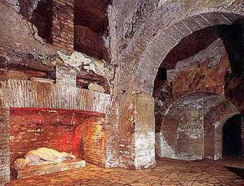
We took advantage of the restrooms and then rested for a pretty long time on a stone wall near the exit from the catacombs. Sue paid a short visit to the bookstore before we resumed our journey to the Castelli Romani in Ezio’s van.
Ezio brought us a pamphlet that was identical to one that Sue had already purchased. He told us that he had talked a friend of his who administered the site into providing him with it. Sue gave the one from Ezio to the Corcorans. As we drove, Ezio let us know that he lived in the Alban Hills, but not in the area that we intended to visit. We drove near the town of Anagnina, which is the last stop on the A line of the Metro. The area south of Rome seemed very pleasant until we passed some Gypsy camps that were easily identifiable by the big piles of trash. Ezio informed us that the Gypsies were a big problem in Italy, and his view coincided with what people had told us earlier in other European countries. For some reason many of the Roma seemed to have no interest whatever in integrating into the rest of society. I did not know a lot about the subject, but it appeared that the governments in several countries had taken significant steps to address the situation. Nothing seemed to work. We drove all the way up to the top of the southernmost of the Alban Hills. This was at one time the location of the ancient city of Tusculum, the site of some famous vacation villas from imperial times. It was also the home of Pope Benedict VIII, his brother John XIX, and their nephew Benedict IX , the only pope who is on the official list more than once. Their family dominated Rome in the first half of the eleventh century. Several other popes probably came from the walled city of Tusculum as well.One chronicler claimed that the last Tusculan pope, Benedict IX, was only ten-years-old when he became pontiff, but most historians think that he was actually about twenty. I have long struggled to imagine how this family, so remote from Rome, managed to control both the city and the papacy for such an extended period.
Tusculum made the mistake of siding with the Holy Roman Emperor against the papacy in the thirteenth century. When Frederick Barbarossa died, the defensive troops pulled out. The Romans immediately attacked, defeated the Tusculans, and then completely destroyed the city in 1191. It was never rebuilt. The refugees migrated to Frascati and other nearby towns. Ezio told us that no one had ever asked him to drive them to the ruins of Tusculum. That did not surprise me. There was not much left to see. Chroniclers reported that not one stone was left upon a stone.We arrived at the edge of the Archeological Park of Tusculum. Ezio parked the van, and Sue and Patti decided to explore the adjoining countryside while Tom and I made the long walk up the hill to the park and archeological area. I did not know what I expected to find. I just wanted to try to conjure up an image of what life could have been like in this place one thousand years earlier.
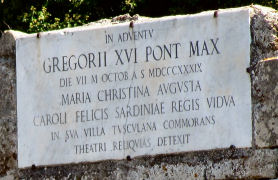
Unfortunately, I did not gain any insight into what life here in the eleventh century must have been like. It still baffled me how one family from this detached area could have controlled Rome for two generations. A lot was blamed on them by their successors, but they must have had quite a bit going for them as well. All three had longer than average pontificates. If I had been hoping that the spectre of Benedict IX would whisper something inspirational in my ear, I was disappointed. The weather might have been a little cooler at this altitude, but not much. That surprised me a little. I had thought that a primary reason for wealthy Romans to locate their villas in the Alban Hills had been to avoid the unbearably hot weather of Rome. The next stop on our itinerary was Grottaferrata, the place where in 1004 Count Gregory, the only person in history who fathered two popes (and he was also grandfather to a third!), donated the land and funds for a monastery[7] in 1004. This building still stands today! It was quite unique in several ways. The founder of the monastery was St. Nilus of Rossano, who was a follower of St. Basil. Despite the monastery’s proximity to Rome and to the most powerful people in the Roman Church, the monks practiced the Greek rite in their worship, not the Roman rite. In fact, this practice even survived the Great Schism. Services in the cathedral[8] still used the Greek rite in the twenty-first century. What attracted me to Grottaferrata, however, was a historical footnote that I had stumbled across. Pope Benedict IX, according to some[9] legends, became a monk after he was driven from the papacy the last time. The monastery that he allegedly joined was none other than Grottaferrata. I had even read that there had formerly been an ancient plaque somewhere on the monastery grounds that commemorated his death at an advanced age in the monastery. Unfortunately, the plaque did not survive World War II. I had no idea whether I might be able to learn anything about this, but I figured that at least I could see what the monastery looked like. I knew that there was a museum there as well, but I had no idea what it contained. It was probably a Quixotic quest, but I would probably never get this chance again, and one never knew what one might discover. The modern town of Grottaferrata was much more bustling than I had anticipated. I am not sure why I expected the monastery to be in the middle of nowhere, but I was wrong. Grottaferrata was a thriving town with plenty of traffic. When the pink van finally reached the parking lot of the monastery and cathedral, we discovered that a wedding had taken place in the church that morning. In fact, the bride was still on the scene posing for pictures. We arrived at the monastery at a little after one, the worst possible time. The church and abbey had both closed for riposo. I explored the grounds and took quite a few photos. The museum was devoted to the big ceremony that was held in 1904 to celebrate the nine hundredth anniversary of the founding of the monastery. The site played host to a huge pilgrimage sanctioned by consecutive popes. I had not expected to find something like this. The priests in the photos definitely looked more like Greek priests – beards, robes, and Greek hats – than the familiar figures with clerical collars. I suspected that they still did.
One thought pressed its way to the forefront of my mind. I could not help wondering why nothing of the magnitude of the 1904 event had been scheduled for 2004, the millennial anniversary of the founding.
Sue knew that I was disappointed, and she bought me a small book written in Italian at the gift shop. She would not let me go in the store while she was engaged in this transaction. The book, however, contained no mention whatever of Pope Benedict IX. It also failed to mention that the monastery’s benefactor, Count Gregory of Tusculum, was the father of two popes and the grandfather of a third. I did learn that the fortification of the monastery in the fifteenth century was instigated by Cardinal Della Rovere, the future Pope Julius II.By this time we were getting hungry. My original plan was for Ezio to leave us off in Frascati for lunch. I figured that we could make our own way back by train without any difficulty. I had read on the Internet that Frascati was a great place to have lunch. One website explained in detail how to get the materials for a lunch of porchetta sandwiches and how to arrange for wine and seating at a nearby cantina.
However, we allowed Ezio to talk us into letting him show us where to get lunch and to take us back to Rome. My desire for some time on our own was trumped by Patti’s physical condition, which was, to say the least, weak. The prospect of walking around looking for the train station was just not in the cards.
So, Ezio parked the van illegally near the cathedral[10] and walked with us through a galleria to the piazza that was described in the Internet posting that I had discovered. Ezio helped us to select our food from a sort of deli that was the closest establishment to the shuttered shack of our original destination, Leda, the Queen of Pork. Patti and I reserved a table while Sue, Ezio, and Tom were inside bargaining with the proprietor. I walked down to check out the cantina where we planned on getting our wine and our table settings. It was a long block or two away, and there was a dog barking in front of it. It was probably fine, but it did not look a bit inviting. I think that my companions would have doubted my sanity if I had forced them to eat there. As it was, we had a very pleasant lunch of fresh roasted pork sandwiches, cheese, olives, some bread that was puzzlingly called pizza, and Frascati white wine. The pork was quite tasty, but the olives, which were freshly harvested, were definitely my favorite. Sue, as usual, gathered up all of the leftovers.Meanwhile, Ezio had himself eaten lunch and had moved the van to the closest legal spot to the piazza in which we took our repast. It was a good thing that he did so. Patti barely had enough energy to make it to the van. I don't know what we would have done if we had dismissed Ezio. I guess that we would have had to find a cab, but I was not certain that they even had cabs in Frascati.
I considered suggesting that we return to Grottaferrata. By the time that we arrived there the church and maybe even the monastery might be open. At the very least we could see what the interior of a church that practiced the Greek rites looked like. However, I suspected that the rest of the group had had about enough of my wild goose chase. So, I suggested that we just go back to Rome. On the return trip Ezio pointed out some aqueducts to us. One of them, he said, was still functioning after two thousand years. He also tried to entice us into stopping at a gelateria that he claimed was the best in Rome. I began to wonder if he, who was after all being paid by the hour, might be trying to extend the trip a little. At any rate we all turned down his suggestion. Ezio let us off at the hotel, and before he left Tom took a photo of Sue and me on either side of him with the pink van in the background. We put on happy faces, but I could not help but think that this was a failure. Lunch had been fun, but at Tusculum and Grottaferrata I had learned next to nothing about the elusive Pope Benedict IX and his powerful family. I probably had just set the bar too high.
It was not even 4:00 yet. I figured that I could go up to Termini and look for an optician to fix my sunglasses and/or an electronics place in which to purchase a mouse. Before entering the station I could buzz across the street to the BNL bank that I had spotted on our walk to La Famiglia the previous evening. Then I planned to return to the Piazza Cinquecento to buy a couple of Metro tickets for a quick trip out to St. Paul’s Outside the Walls, the second- or third-ranking church in the city. Nobody else was interested in accompanying me, so I set out on my own again.
The trip started poorly. I found the BNL without any problem, but I was not able to get either of the bancomats to give me any money. The one on the La Famiglia side appeared to be completely dead. The screen was just black. I noticed a young lady using – or attempting to use – the one on the Termini side. By the time I got there she had left. The sun was over my right shoulder, which meant that the screen was almost impossible to read. This one seemed to have some life in it, but I could not effect a withdrawal. It was very frustrating.
I went to Termini to see if I could find an optician or a place that sold computer peripherals. I went up and down the lines of merchants, but I could find neither. However, I did find another BNL bancomat, and this time I was able to obtain €250 without any problem whatsoever. I looked for the optician and the electronics place again to no avail. So, I bought my Metro tickets and took Line B to the San Paolo station, which was one stop past Piramide. I exited the station with no idea how to find the basilica. The very first thing that I laid eyes on was a small computer store that was completely shuttered up. It was as if Fate were rubbing my nose in it.I turned left and spotted a McDonald’s. The basilica was the only major attraction in this area, so I must be getting warm. Sure enough, just beyond McDonald’s on the other side of the street was a very large church. The entrance was on the far side.
As I approached the church I heard a cascading of bells. I looked at my watch[11] and saw that it was 4:45. To my way of thinking this was much too large a number of bells for a quarter hour. I deduced that there must be a mass scheduled for five o'clock. I hurried to get into the church before the service started.
Basically St. Paul’s was a huge church that was almost completely empty. I suspected that there were hidden treasures somewhere on the grounds, but I did not know where to look for them.I did, however, know where to look for the mosaics of the popes. The easiest one to find was the one of Pope Benedict XVI. A spotlight of some kind was trained on it. It was difficult to photograph any of the other mosaics. They were all very high, and I had to stand back away from them to take a reasonable shot. To make matters worse, the only light in the church came from the open doors that I had entered. This lit the two rows of portraits in the center fairly well, but the ones in the side aisles were almost invisible in the shadows.
At five o'clock mass began. It was being celebrated with a few attendees way down in the apse. My surreptitious investigation of the pontifical portraits in the nave and transept could not conceivably disturb any of the attendees.
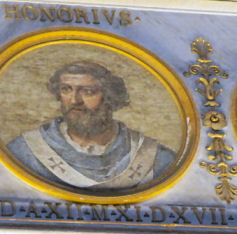 Pope Honorius I was posthumously excommunicated for heresy. The text below the picture indicates his term: 12 years, 11 months, and 17 days. |
I began by looking for some of the popes about whom I had read extensively. I soon found Pope Formosus, whose bizarre legacy inspired my maniacal fascination with the subject of the papacy.[12] I then located Pope John XII, almost certainly the youngest pope. He was no more than twenty-five when he died. His portrait did not look at all like what I expected. I found Urban II, whose rhetoric inspired the Crusades. Then I looked for Benedict IX and two popes of nearly the same period, Gregory VI, who bought the papacy from Benedict, and Gregory VII, whose pontificate reached immeasurable heights before plunging into disaster and exile.
Then I got a mischievous idea. I wondered if the basilica’s collection of mosaics included any fictitious popes. The ones that first popped to mind were Donus II and Cletus/Anacletus. Several minutes of difficult searching ensued. In many cases the mosaics were so poorly lit that I could not read them. I often had to shoot a photo at maximum (i.e., 12x) zoom and then look at my display to try to figure out which pontiff I was squinting at. Another problem was that I did not have a list of the popes with me; I had to rely on memory.
Nevertheless, I found the portraits of Donus II, Anacletus, and Cletus. I then wondered whether any antipopes had slipped into the basilica. The most likely candidates in my estimation were the first Pope John XXIII and Pope Boniface VII. The popes of the early fifteenth century were in a very dark corner of the basilica. I took a dim photo of a pope whom I was able to determine was Martin V, the first pope after the Western Schism. I could not visually identify his predecessor, but I put the timer on two seconds, held my hand as steady as I could, and snapped the shot. I looked at the result and could scarcely believe my eyes. It was Pope John XXIII all right, but this was not the pontiff who had recently been beatified and whose cadaver I had seen the previous day on display in St. Peter’s. This was the fellow who was elected by a bunch of disgruntled renegade cardinals in Pisa while the elected pope reigned in Rome. This Pope John was later convicted by the Council of Constance of piracy, murder, rape, sodomy, and incest. And yet, there he was in a position of honor in one of the most sacred churches in Christendom.I also located the mosaic of the first Pope Stephen II, who was by all accounts legitimately elected. However, he died only three days later, and whoever wields the White-out at the Vatican removed him from the list.
When the new list was published in 1947, someone at St. Paul’s must surely have wondered if they had on display mosaics of any of the removed popes. Anyone with a flashlight could easily find the answer. Someone must have then offered some sort of rationale for leaving the erroneous mosaics up. Money? Tradition? Doubt that anyone would notice? Certainly it could not have been for artistic reasons; the mosaics even reported the number of years, months, and days that these imposters supposedly ruled the Church.
In most other religions such mistakes would just be interesting anomalies, but the pope was considered to be infallible. That the Church was on several occasions confused about who was the real pope spoke volumes.
I must say that I had a lot of fun doing this. I had tried to make this kind of search with the busts of the popes in the duomo in Siena,[13] but I was frustrated by a paucity of knowledge and an inferior camera.
I was beginning to suffer from eye strain, but I walked out of the church in a triumphant mood,[14] snapped a few shots of the exterior of the basilica, and then made the uneventful walk and subway trip back to the hotel. I immediately downloaded the photos and shortly thereafter fell asleep.
I awoke an hour or so later and helped myself to the leftover bread that the shop in Frascati called “pizza” for supper. This was sufficient; I had stuffed myself at lunch.I signed on to the Internet and learned that Michigan had defeated Minnesota 58-0. Good heavens! I thought that the Wolverines would definitely win, but I did not expect such a blowout. I was less happy to learn that the stock market had tanked on Friday.
I worked on this journal for as long as I could stomach it. Putting this thing together involves a great deal of work. I always get a rush when the final product comes together, but the process can be quite tiresome.
Sue, Tom, and Patti decided to take a cab to Trevi fountain. They invited me to go with them, but I had no interest in seeing it again. I planned to return to the Eternal City whether or not I left some coins there. It was my favorite city in the world.I had somehow neglected to pack as many short-sleeved shirts as I intended. I decided to take advantage of the fact that I was alone in the room to wash the orange one in the sink. I figured that it would be pretty well dry by the time that we had to change hotels on Monday morning.
After they returned, Tom expressed the need to obtain some more euros. He informed me that there was a big mall in the basement of Termini. I advised him not to bother trying the bancomats at the BNL branch. I also described (slightly erroneously) where the one inside Termini was. This exchange exemplified why we preferred to travel with another couple.
The weather.com website described a chance of rain next weekend. Until then we could expect our run of dry weather to continue.
[1] Presumably when he determined that he was at the wrong hotel, he called his office from the van to find out the name and address of our hotel.
[2] Usually I am prepared to take notes, but on this occasion my notebook was in my backpack.
[3] If you consider 650,000 years ago recent. The Sabatini Mountains, which are northwest of the city, are also volcanic.
[4] I already knew this from watching “Hogan’s Heroes.”
[5] All nine are considered saints. If lime was poured on them to accelerate decomposition, then there are probably no relics (or at least no legitimate relics) of any of them. The medieval and Renaissance popes must have cursed this wanton destruction of a reliable source of income. Bones of many saints were broken into tiny splinters and sold as precious totems.
[6] In my ignorance I thought that the archeologists were trying to reconstruct the medieval Tusculum. Actually the theater, the forum, and the other archeeological sites are from ten or so centuries earlier.
[7] It was originally called Cryptoferrata.
[8] It is a cathedral even though Grottaferrata is within the diocese of Frascati, which has a much larger cathedral.
[9] But not all. The nineteenth-century French writer Cormenin claimed that he became pope an additional two times. He also accused Benedict of murdering a few popes.
[10] After Tusculum had been wiped off of the map, the episcopal functions were transferred to Frascati.
[11] Yes, a watch. Many people of my generation still wear watches.
[12] In 2003 I heard a report on NPR’s Saturday “Weekend Edition.” A. J. Jacobs had been reading the Encyclopedia Brittanica from cover to cover. His highlights from the letter F focused on Pope Formosus and the Cadaver Synod. I was inspired to find out what was behind such a bizarre occurrence, and I kept discovering equally interesting (to me at least) people and events in all directions.
[13] I have read that the duomo once contained a bust of the mythical Pope Joan, but I have been unable to confirm it.
[14] Why would anyone care about scarcely visible mosaics in a church that is not even a cathedral? Well, Christianity may be about being born again or the two great commandments or the sermon on the mount or fulfilling prophecy, but Catholicism is about the pope. It is based upon an unbroken chain from St. Peter to Benedict XVI. The fact that the people running an important basilica and pilgrimage site in the pope’s own diocese could not tell a legitimate pope from a fake or even from a non-entity must surely argue strongly against the validity of the one-chain principle. And without that principle, ...
